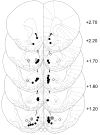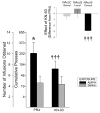Inhibition of CaMKII in the nucleus accumbens shell decreases enhanced amphetamine intake in sensitized rats
- PMID: 18694805
- PMCID: PMC2703195
- DOI: 10.1016/j.neulet.2008.08.004
Inhibition of CaMKII in the nucleus accumbens shell decreases enhanced amphetamine intake in sensitized rats
Abstract
Microinjection of the calcium/calmodulin-dependent protein kinase II (CaMKII) inhibitor KN-93 into the nucleus accumbens (NAcc) shell impairs expression of the sensitized locomotion and NAcc dopamine (DA) overflow normally observed in psychostimulant-exposed rats. Based on these results, we investigated the effect of NAcc shell KN-93 on the enhanced amphetamine (AMPH) intake normally observed in AMPH- relative to saline-exposed rats. Rats were administered five injections of either AMPH (1.5mg/kg, i.p.) or saline, one injection every 2-3 days. Fourteen days following the last injection, they were trained to self-administer AMPH (200 microg/kg/infusion, i.v.) first on fixed ratio schedules (FR) and then on a progressive ratio schedule of reinforcement (PR). As expected, AMPH-exposed rats worked harder and obtained significantly more drug infusions than saline-exposed rats on the PR schedule. After 4 days of stable responding, all rats were bilaterally microinjected with KN-93 (1 or 10 nmol/0.5 microl/side) into the NAcc shell, 2 min prior to the beginning of the self-administration session. Inhibiting CaMKII in this site reduced the enhanced drug intake observed in AMPH-exposed rats to levels no longer significantly different from those of saline-exposed rats. Responding in these latter controls was not affected by KN-93 nor did KN-93 affect responding in AMPH-exposed rats when it was infused into the NAcc core. Thus, in a manner similar to what has been reported for sensitized locomotion and NAcc DA overflow, these results suggest that inhibiting CaMKII in the NAcc shell attenuates the enhanced motivation to obtain a drug reinforcer that is normally displayed in AMPH-exposed rats.
Figures



Similar articles
-
Transient overexpression of alpha-Ca2+/calmodulin-dependent protein kinase II in the nucleus accumbens shell enhances behavioral responding to amphetamine.J Neurosci. 2010 Jan 20;30(3):939-49. doi: 10.1523/JNEUROSCI.4383-09.2010. J Neurosci. 2010. PMID: 20089902 Free PMC article.
-
Previous exposure to psychostimulants enhances the reinstatement of cocaine seeking by nucleus accumbens AMPA.Neuropsychopharmacology. 2004 Dec;29(12):2149-59. doi: 10.1038/sj.npp.1300533. Neuropsychopharmacology. 2004. PMID: 15266353
-
Previous exposure to VTA amphetamine enhances cocaine self-administration under a progressive ratio schedule in a D1 dopamine receptor dependent manner.Neuropsychopharmacology. 2002 Dec;27(6):970-9. doi: 10.1016/S0893-133X(02)00379-2. Neuropsychopharmacology. 2002. PMID: 12464454
-
Previous exposure to amphetamine enhances the subsequent locomotor response to a D1 dopamine receptor agonist when glutamate reuptake is inhibited.J Neurosci. 2001 Mar 1;21(5):RC133. doi: 10.1523/JNEUROSCI.21-05-j0003.2001. J Neurosci. 2001. PMID: 11222671 Free PMC article.
-
Maladaptive consequences of repeated intermittent exposure to uncertainty.Prog Neuropsychopharmacol Biol Psychiatry. 2020 Apr 20;99:109864. doi: 10.1016/j.pnpbp.2020.109864. Epub 2020 Jan 15. Prog Neuropsychopharmacol Biol Psychiatry. 2020. PMID: 31952958 Free PMC article. Review.
Cited by
-
Decreased Caffeine-Induced Locomotor Activity via Microinjection of CART Peptide into the Nucleus Accumbens Is Linked to Inhibition of the pCaMKIIa-D3R Interaction.PLoS One. 2016 Jul 12;11(7):e0159104. doi: 10.1371/journal.pone.0159104. eCollection 2016. PLoS One. 2016. PMID: 27404570 Free PMC article.
-
Behavioral and structural responses to chronic cocaine require a feedforward loop involving ΔFosB and calcium/calmodulin-dependent protein kinase II in the nucleus accumbens shell.J Neurosci. 2013 Mar 6;33(10):4295-307. doi: 10.1523/JNEUROSCI.5192-12.2013. J Neurosci. 2013. PMID: 23467346 Free PMC article.
-
Transient viral-mediated overexpression of alpha-calcium/calmodulin-dependent protein kinase II in the nucleus accumbens shell leads to long-lasting functional upregulation of alpha-amino-3-hydroxyl-5-methyl-4-isoxazole-propionate receptors: dopamine type-1 receptor and protein kinase A dependence.Eur J Neurosci. 2010 Apr;31(7):1243-51. doi: 10.1111/j.1460-9568.2010.07155.x. Epub 2010 Mar 19. Eur J Neurosci. 2010. PMID: 20345911 Free PMC article.
-
Dopamine D1-D2 receptor heteromer signaling pathway in the brain: emerging physiological relevance.Mol Brain. 2011 Jun 13;4:26. doi: 10.1186/1756-6606-4-26. Mol Brain. 2011. PMID: 21663703 Free PMC article.
-
Threonine 149 phosphorylation enhances ΔFosB transcriptional activity to control psychomotor responses to cocaine.J Neurosci. 2014 Aug 20;34(34):11461-9. doi: 10.1523/JNEUROSCI.1611-14.2014. J Neurosci. 2014. PMID: 25143625 Free PMC article.
References
-
- Anderson SM, Famous KR, Sadri-Vakili G, Kumaresan V, Schmidt HD, Bass CE, Terwilliger EF, Cha JJ, Pierce RC. CaMKII: A Biochemical bridge linking accumbens dopamine and glutamate systems in cocaine seeking. Nat Neurosci. 2008;11:344–353. - PubMed
-
- Fog JU, Khoshbouei H, Holy M, Owens WA, Vaegter CB, Sen N, Nikandrova Y, Bowton E, McMahon DG, Colbran RJ, Daws LC, Sitte HH, Javitch JA, Galli A, Gether U. Calmodulin Kinase II interacts with the dopamine transporter C terminus to regulate amphetamine-induced reverse transport. Neuron. 2006;51:417–429. - PubMed
-
- Goto S, Yamada K, Oyama T, Korematsu K, Nagahiro S, Ushio Y, Fukunaga K, Miyamoto E, Hofer W. Cellular localization of type II Ca2+/calmodulin-dependent protein kinase in the rat basal ganglia and intrastriatal grafts derived from fetal striatal primordia, in comparison with that of Ca2+/calmodulin-regulated protein phosphatase, calcineurin. Neuroscience. 1994;62:695–705. - PubMed
-
- Iwata S, Hewlett GHK, Ferrell ST, Kantor L, Gnegy ME. Enhanced dopamine release and phosphorylation of synapsin I and neuromodulin in striatal synaptosomes after repeated amphetamine. J Pharm Exp Ther. 1997;283:1445–1452. - PubMed
-
- Kalivas PW, Stewart J. Dopamine transmission in the initiation and expression of drug- and stress-induced sensitization of motor activity. Brain Res Brain Res Rev. 1991;16:223–244. - PubMed
Publication types
MeSH terms
Substances
Grants and funding
LinkOut - more resources
Full Text Sources
Research Materials

